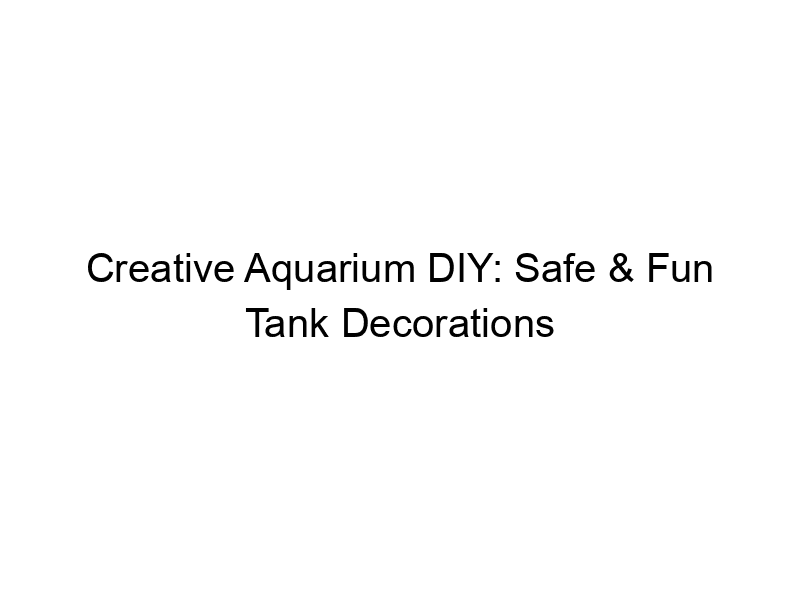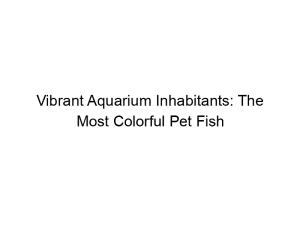Creating a thriving and visually appealing aquarium is a rewarding hobby, and DIY fish tank decorations offer a fantastic way to personalize your underwater world while saving money. This comprehensive guide explores safe and fun DIY projects, from simple additions to more intricate creations, ensuring the well-being of your aquatic pets. You’ll learn about choosing safe materials, designing aesthetically pleasing decorations, and avoiding common pitfalls. Let’s dive in!
Choosing non-toxic materials is paramount. Avoid paints, glues, plastics, and metals that might leach harmful chemicals into the water. Always research the specific toxicity of any material before introducing it to your tank.
Safe materials include smooth, non-porous stones (like river rocks), certain types of wood (after proper curing), and ceramic items (ensure they are glazed and free of lead). Avoid anything treated
with chemicals or pesticides.
Avoiding Harmful Substances
Harmful substances include lead-based paints, untreated woods, and any materials that could release toxins or sharp fragments into the water, harming your fish. Thoroughly research any material before using it.
DIY Decoration Ideas: Easy Projects
Simple Rock Arrangements
Arrange different sizes and colors of smooth river rocks to create natural-looking formations. You can even build miniature caves and hideaways for your fish.
Creating a Natural Background
Using cork bark or other natural, porous materials provides a beautiful background and creates hiding places. Always soak and thoroughly clean the materials before introducing them to the tank.
Making DIY Planter Pots
Use small, unglazed clay pots (ensure they’re properly cured and free from toxins) and fill them with aquarium-safe substrate for live plants. These pots add visual interest and serve as a beneficial habitat for your fish.
Advanced DIY Decorations: Challenging But Rewarding
Sculpting with Aquarium-Safe Silicone
Silicone sealant (specifically labeled as aquarium-safe) allows for more creative freedom. You can sculpt various shapes and structures, but ensure it fully cures before submerging it.
Building a DIY Castle
Construct a castle from aquarium-safe rocks, silicone, and other materials for a captivating centerpiece. This project requires patience and attention to detail, but the results are striking.
Creating a Realistic Coral Reef
A challenging project, but an effective way to enhance visual appeal and provide shelter. You’ll need several kinds of safe materials and an eye for detail to achieve realism.
Incorporating Live Plants into Your DIY Designs
Selecting Appropriate Plants
Choose aquatic plants suitable for your tank’s conditions (lighting, substrate, water parameters). Research individual plant needs before purchasing.
Planting Techniques
Proper planting methods ensure plant survival and help maintain water quality. Use appropriate substrate and avoid damaging the roots.
Maintaining Plant Health
Regularly trim and maintain your plants to prevent overgrowth and maintain a balanced aquarium ecosystem. This helps prevent algae blooms and promotes a healthy environment.
Budget-Friendly DIY Decorations
Repurposing Household Items
Get creative with safe household items like smooth, rounded ceramic pieces, glass, or properly treated driftwood (ensure it’s thoroughly cleaned and cured).
Upcycling Materials
Give old toys or other suitable materials a new life as aquarium decorations. Remove all paint or potentially harmful elements before repurposing.
Cost Comparison with Store-Bought Decorations
Making your own decorations is significantly more affordable than buying pre-made ones, allowing you to invest more in your fish and tank maintenance.
Safety Precautions & Maintenance
Thorough Cleaning of Materials
Clean all materials thoroughly before introducing them to the tank. Soak them in dechlorinated water for at least 24 hours to remove any potential contaminants.
Proper Curing of Materials (Wood, Clay)
Some materials need to be cured appropriately before use. Wood, for instance, should be boiled, dried, and thoroughly cleaned to prevent leaching tannins or other harmful substances.
Regular Tank Maintenance
Regular water changes, filter cleaning, and substrate maintenance are essential to maintain a clean and healthy aquarium environment regardless of the decorations.
Troubleshooting DIY Decorations
Fixing Damaged Decorations
Learn how to repair minor damage to your decorations. This could involve using aquarium-safe sealant or replacing damaged elements.
Addressing Algae Growth on Decorations
Algae growth is common. Regular maintenance and proper tank hygiene will minimize this issue. Utilize algae-eating snails or manual cleaning if needed.
Relocating Decorations
Sometimes decorations need repositioning. Do so carefully to avoid disturbing your fish or damaging the aquarium setup.
Frequently Asked Questions
What materials should I avoid when making DIY fish tank decorations?
Avoid any materials that are porous, untreated, painted with non-aquarium-safe paints, or contain any metals that can leach toxins into the water. This includes untreated wood (unless properly cured), plastic toys, and any materials you’re unsure of.
How do I ensure my DIY decorations are safe for my fish?
Always thoroughly clean and cure your materials. Research any potential toxins. If uncertain, it’s best to err on the side of caution and not use the material. Prioritize aquarium-safe silicones and glues.
Can I use paint on my DIY fish tank decorations?
Only use paints specifically designed for use in aquariums. Regular paints often contain harmful chemicals that can harm your fish.
How can I prevent algae growth on my DIY decorations?
Maintain good tank hygiene, perform regular water changes, and provide adequate filtration. Algae-eating snails can also help control algae growth.
What types of wood are safe for aquariums?
Certain types of hardwood, like Mopani wood, are suitable after proper curing. Avoid softwoods which can release tannins and other harmful substances. Thoroughly clean and cure the wood to prevent leaching.
How do I attach decorations to the tank walls or the substrate?
Aquarium-safe silicone is an effective way to attach decorations securely. Use suction cups for smaller or lighter decorations.
What are some common mistakes to avoid when making DIY fish tank decorations?
Avoid using materials with sharp edges or fragments. Don’t introduce anything before thorough cleaning and curing. Avoid overcrowding the tank with decorations, leaving sufficient space for your fish to swim and explore.
Where can I find aquarium-safe materials?
Specialty aquarium stores often carry safe and suitable materials. You can also find suitable materials at craft stores, ensuring they are non-toxic and appropriately treated before use.
Final Thoughts
Creating your own DIY fish tank decorations is a rewarding experience. It allows you to personalize your aquarium, express your creativity, and save money. By following the safety guidelines and choosing appropriate materials, you can enhance your aquarium’s visual appeal while ensuring a healthy environment for your fish. Remember to always prioritize the well-being of your aquatic pets. Start with simple projects and gradually explore more intricate designs as you gain confidence and experience. Remember to clean and cure your materials carefully before placing them in the tank! Enjoy the process and watch your aquarium transform into a unique and thriving ecosystem. Now, go ahead and unleash your creativity!




